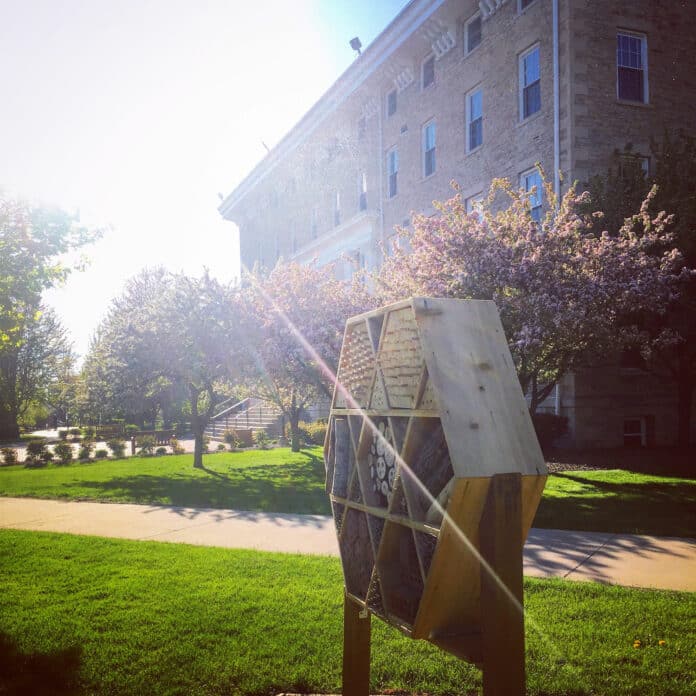Local biodiversity is in danger as cities’ populations rise and urban development density rises. In recent decades, there have been global decreases in the diversity of wild bees that have coincided with rising human populations and the expansion of urban areas. However, an increased understanding of the richness of wild bees in urban areas can benefit conservation and management efforts for urban green space.
Urban ecosystems depend on wild native bees for pollination, but little is known about how urban landscape management affects the richness and composition of pollinator communities. In a recent study published in the journal PLoS ONE, researchers looked at how urban greenspaces in and around Appleton, Wisconsin—a medium-sized urban town with a land area of more than 100 square kilometers—affect wild bee communities.
The goal was to determine which greenspace attributes best predict wild bee richness and abundance.
The study took place in the Fox Cities area of northeastern Wisconsin, which includes the cities of Appleton, Menasha, Fox Crossing, Kimberly Kaukauna, and Neenah. The urban region is surrounded by a mix of deciduous forest, natural grassland, pasture, and cropland. A total of 16 sites were chosen in urban and suburban green spaces.
The 16 sites were classified into three categories:
- Unmanaged urban sites.
- Managed urban sites.
- Managed suburban sites.
For sampling urban bees, the study employed systematic, standardized methods. They gathered data from May through September 2017 and again from June through September 2018. At each location, samples were methodically gathered using a collection of 16 pan-trap trays. To take into account how differently sensitive different species and sexes of bees were to pan color, pans were colored red, blue, yellow, and white. Each pan was handled as an individual sample.
At the end of each 12-hour sampling period, specimens were collected in the field, preserved in ethanol, then taken back to the lab for pinning and identification.
Rural managed sites tended to be in the more undeveloped northern extent of the city, and city parks tended to follow the waterways and lakes in the city. Given this study’s relatively small spatial scale, all bee species have equal potential to colonize any given site given enough time to disperse, as the sites are no more than 16 km apart in distance.
In this survey, scientists identified a total of 1516 individuals belonging to 86 distinct species and 20 genera. Both wild bee abundance and species richness were correlated with greenspace attributes and management practices. Floral diversity was a major predictor of both wild bee abundance and richness. Floral diversity became a stronger predictor of abundance and richness when paired with management style.
Urban and suburban-managed sites did not vary greatly in bee abundance or species richness compared to each other. Still, bee abundance increased significantly in managed sites compared to unmanaged sites.
Study authors noted, “Our results have the potential to improve bee conservation efforts through the development of greenspace management practices that are more efficient and cost-effective for improving wild bee habitat in urban areas. Doing things like replacing ornamental with native flora, reducing chemical use, and mowing frequency all have the potential to attract native wild bees.”
“We also found that wild bee abundance and richness was strongly associated with proximity to open water. To our knowledge, ours is the first study to find a positive indirect relationship between urban bee communities and water resources. This relationship may be explained by the tendency of lakes, rivers, and streams to be associated with wet meadows and similar low-lying areas suitable for a variety of herbaceous plant species, which in turn support more diverse pollinator communities.”
“Our results do not reflect potential diversity patterns in unmanaged suburban sites. Future research could address the relationship between pollinator diversity and traditionally managed landscapes that are not focused on pollinators, thus, adding a missing piece of knowledge about these unmanaged suburban sites into pollinator biodiversity assessments.”
Journal Reference:
- Anderson M, Crubaugh F, Greenslit C, Hill E, Kroth H, Stanislawski E, et al. (2023) B.Y.O. Bees: Managing wild bee biodiversity in urban greenspaces. PLoS ONE 18(4): e0281468. DOI: 10.1371/journal.pone.0281468
